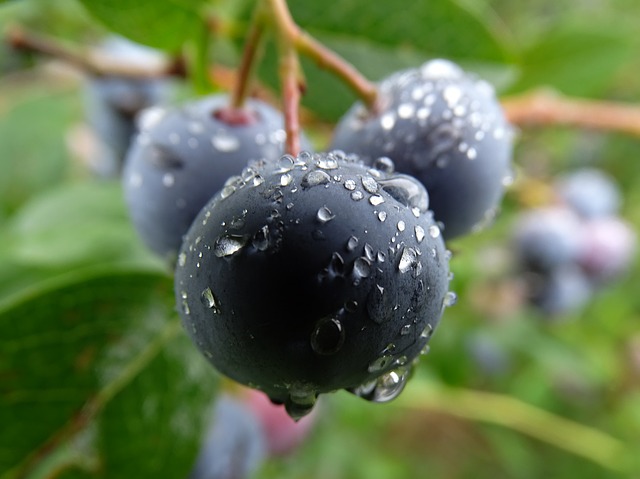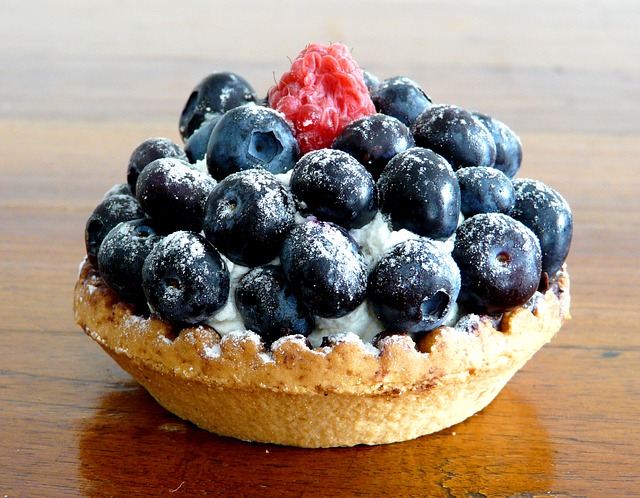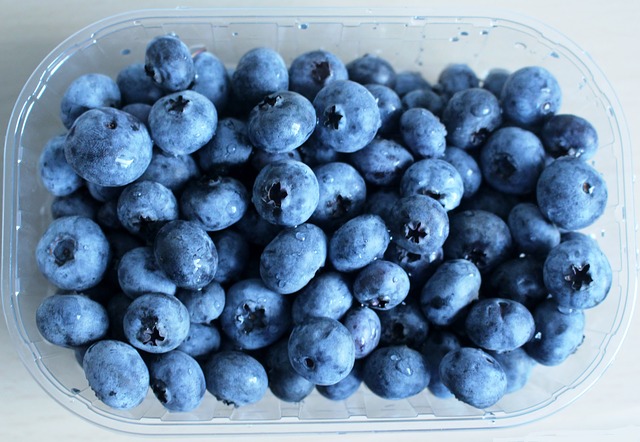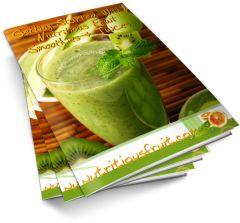Blueberries: Origins - Consumption - Nutrition Facts - Health Benefits
|
|
|
Contents
- Geographic origin and regions grown
- History of consumption
- Common consumption today
- Nutrition Facts: Vitamins, minerals and phytochemical components
- Health Benefits: Medicinal uses based on scientific studies
- Bibliography
Geographic Origins and Regions Grown

Blueberries are flowering plants from the genus Vaccinium. This plant species is native to North America, most of Asia, and Scandinavia. Blueberry shrubs grow in a variety of sizes that vary from a few inches to 10 feet. The plant also makes colored flowers which may be one of many colors like white, pale pink, red, and sometimes light green. The plant bares small blueberry fruits that have a dark purple color.
They have a sweet taste when ripe and the plants produce fruit once a year during the summer months. Vaccinium is the name for the entire blueberry family and includes hundreds of other related plants. Other names by which the blueberry is known include: cowberry, cranberry, farkleberry, lingonberry, partridgeberry, whortleberry, and sparkleberry.
North America is the number one producer of blueberries, with an astounding nearly 90 percent of world’s blueberries being grown in the US currently. Although the USA and Canada are the largest producers and consumers of blueberries, the market around the world is on the rise with Japan in particular becoming a blueberry loving nation.
History of Consumption
The blueberry has been consumed by the native North American Indians for hundreds of years. Surprisingly, the blueberry plant is associated with more folklore than most American fruits. Many years ago after the Europeans arrived in North America, they began to cultivate blueberry farms and took the blueberry plant back to Europe with them. Soon after that, blueberries became popular in many European countries and were no longer a popular fruit in just North America. Today the fruit is well recognized for its sweetness and is sold worldwide.
Besides the fruit, the berries are also crushed and the juice is extracted. The North American Indians have used blueberry juices for years to treat numerous medical ailments as well as a dying agent for their clothes. The dried berries were also crushed into a powder and rubbed into meat for flavor.
As the centuries progressed, blueberries became an important food source and were preserved, and later canned. In addition, a beverage made with blueberries was an important staple for soldiers during the Civil War. In the 1880s a blueberry canning industry began in the Northeast of the USA. The leaves and roots of blueberry plants were also used quite often in combination with the fruit for medicinal purposes.
Common Consumption Today

Delicious fresh blueberries are a summertime treat and tradition in North America. About 50 percent of all blueberries produced are dedicated to the fresh fruit market. Blueberry season takes place in the summer when the berry has a deep blue color. During this season the blueberries are carefully handpicked and immediately packaged. To preserve their flavor, they are chilled and rushed to markets in the nearby cities and shipped by air freight around the world.
Blueberries are usually sold fresh or first processed and then sold as frozen fruits, juice, purée or dried fruits. Regardless of the way blueberries are purchased, they are typically used in a variety of foods such as pies, jams, snacks, muffins and cereals.
Nutrition Facts: Vitamins, Minerals and Phytochemical Components
Blueberries have earned the reputation of a super fruit and evidence indicates that the fruit is rich in nutrients like fiber, vitamin K, vitamin C, iron, and large amounts of manganese. Blueberries also contain resveratrol, which is a phytoalexin that is produced by plants when they are experiencing a bacterial or fungal infection. Phytoalexins are antibacterial and anti-fungal chemicals that are produced by plants as a means of protection against pathogens.
In 1997, it was discovered that resveratrol also has anti-inflammatory properties (2). Recently resveratrol has been labeled as a nutraceutical because its chemical properties provide protection against chronic diseases (1). In addition to resveratrol, blueberries contain anthocyanins and polyphenol antioxidant pigments that have been shown to help reduce the risk of getting some diseases such as certain types of cancers (4).

Health Benefits: Medicinal Uses Based on Scientific Studies
Laboratory studies with blueberries have revealed that its phytochemicals like tannins, flavonols, anthocyanins and proanthocyanidins inhibit some of the ways by which cancer cells grow and develop (4). Blueberries have also been shown to diminish the signs of dementia and improve cognition in Alzheimer’s patients (3).
Other preliminary research has determined that blueberries can lower the amount of damage after a stroke (6). Blueberries also improve symptoms caused by urinary tract or bladder infections, improve skin tone and turgor, and lower cholesterol (5).
Current studies are being performed to determine which compounds in blueberries are most beneficial for heart disease. As of now, the blueberry can be simply enjoyed as a delicious fruit and all the other medical benefits are just a bonus.
Bibliography
1. Health Canada. (1998) Policy Paper on Nutraceuticals/Functional Foods and Health Claims on Foods. Health protection branch, 1-29.
2. Jang M, Cai L, Udeani G, Slowing K, Thomas C, Beecher C, Fong H, Farnsworth N, Kinghorn A, Mehta R, Moon R, Pezzuto J. (1997) Cancer chemopreventive activity of resveratrol, a natural product derived from grapes. Science, 275: 218-220.
3. Joseph, J.A., Shukitt-Hale B., Denisova, N.A. Bielinksi D., Martin, A., McEwen, J.J., & Bickford, P.C., 1999. Reversals of age-related declines in neuronal signal transduction, cognitive, and motor behavioral deficits with blueberry, spinach, or strawberry dietary supplementation. Journal of Neuroscience 19 (18): 8114–8121.
4. Matchett, M.D., MacKinnon, S.L., Sweeney, M.I., Gottschall-Pass, K.T., and Hurta, R.A.R. Blueberry flavonoids inhibit matrix metalloproteinase activity in DU145 human prostate cancer cells. Biochem Cell Biol. 83: 637-643, 2005.
5. Sumner, Judith (2004). American Household Botany: A History of Useful Plants, 1620-1900. Timber Press, 125.
6. Sweeney M.I., Kalt W., MacKinnon S.L., Ashby J. and Gottschall-Pass K.T. Feeding of diets enriched in lowbush blueberries (Vaccinium angustifolium) for six weeks decreases stroke severity in rats. Nutritional Neuroscience 5: 427-431, 2002.
Disclaimer
Nutritiousfruit.com provides this website as a service. Although the information contained within the website is periodically updated, no guarantee is given that the information provided is correct, complete, and/or up-to-date. The materials contained on this website are provided for general information purposes only and do not constitute legal or other professional advice on any subject matter. Nutrtiousfruit.com does not accept any responsibility for any loss, which may arise from reliance on information contained on this website. The information and references in this website are intended solely for the general information for the reader. The content of this website are not intended to offer personal medical advice, diagnose health problems or to be used for treatment purposes. It is not a substitute for medical care provided by a licensed and qualified health professional. Please consult your health care provider for any advice on medications.
Didn't find what you were looking for? Search here...

Amazon Search Box:
Did you like this page?
|
|
|




